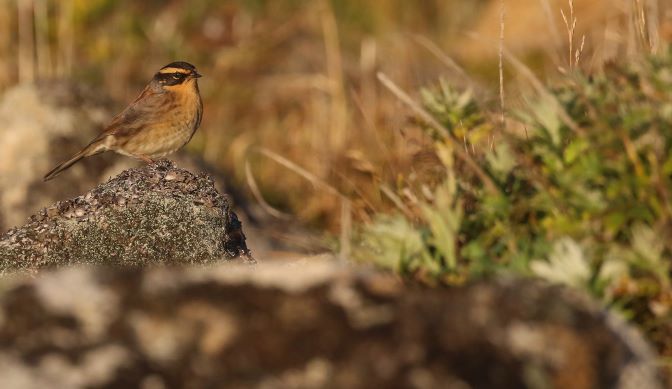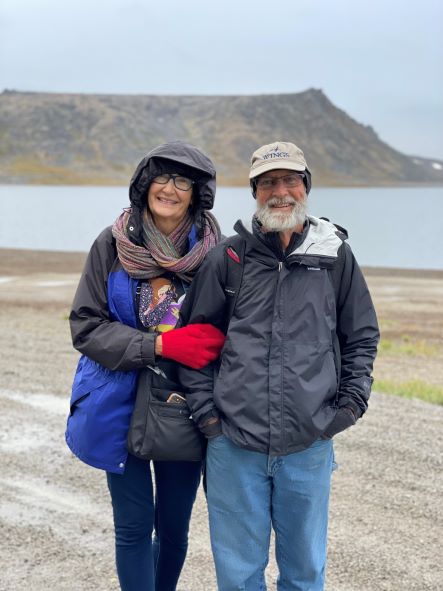Raymond reports from our Alaska - Fall Migration in Gambell tour:
Fall migration on the Bering Sea islands is unpredictable and exciting, as this tour proved yet again! Few things had changed at Gambell since our last fall visit, in 2019. Many ATVs had fallen into disrepair during the height of the Covid-19 pandemic, which made for some bumpy birding, but the locals greeted us with beautiful smiles on their faces, breathtaking ivory carvings, and were as welcoming as ever. A notable difference from our last trip was the presence of sunshine, very little rain, and many vagrant birds from Asia! We encountered all expected trans-Beringean migrants, including large flocks of White Wagtails and Northern Wheatears, two Eastern Yellow Wagtails, many Bluethroats (all without blue throats), and multiple small groups of Red-throated Pipits. Arctic Warblers were surprisingly scarce with only two very brief, very poor views.

The group boarding the plane to Gambell (Howell)

Group photo
Our list of rare Asian vagrants was impressive, with Siberian Chiffchaff, and Middendorff’s Grasshopper-Warbler, representing the most unexpected, both with fewer than 16 records for North America. The juvenile Middendorff’s Grasshopper-Warbler (right) was not merely seen, it was seen incredibly well, with extended scope views on open gravel – very uncharacteristic of the species. Perhaps it had just completed an open-ocean crossing moments before being found and was simply exhausted (most likey), or maybe Raymond scared it into sitting-still when he leapt from his ATV to document the fleeting bird upon initial discovery. Whatever the reason for the uncharacteristic behavior it was most welcome. It’s not often that you hear, “Middendorff’s is in the scope”, or even more impressive, “Middendorff’s is still in the scope!” 
Middendorff’s Grasshopper-Warbler
The list of vagrants doesn't stop there, in addition to the two megas, we encountered multiple Dusky Warblers, and three Siberian Accentors during our routine boneyard stomps.

One of at least two Dusky Warblers seen on September 4th in the Far Boneyard

Siberian Accentor
Gray-tailed Tattler made us work hard this year, encountering Wandering Tattler on three occasions, before finally finding one along the west side of Troutman Lake on the day before departure. In general, shorebirds were few and far between on this tour but what views we did have were very nice. A favorite moment for many was enjoying a spectacularly plumaged Sharp-tailed Sandpiper (right) mousing its way through the grass, mere feet from the group, for upwards of 10 minutes.

Sharp-tailed Sandpiper
Seawatch seemed slow overall compared to previous years, perhaps due to the slightly later tour dates, or maybe because we had fewer days of north winds. Despite lower species diversity than expected we still witnessed impressive migratory activity with Short-tailed Shearwaters gunning past the point in the thousands, beginning their journeys back to nesting grounds around Tasmania. Yellow-billed Loons were only seen twice, and not for long. Steller’s and King Eiders flew by but were always distant. We made up for these views with close encounters of King, Common, and Spectacled eiders around Safety Lagoon in Nome. Alcids of all shapes and sizes were seen most days at seawatch, with large groups of Horned and Tufted puffins barreling past most mornings. Least, Crested, and Parakeet auklets were seen mostly near their nesting cliffs, some of which were still attending burrows, but most of which were forming small, mixed species rafts offshore.
A small, and lucky, group of birders witnessed a male Snowy Owl fly right over the lodge late one evening while preparing for an evening of seawatch and sewage. Despite our attempts to track it down the runway, with ATVs at full speed, we were unable to refind it. Snowies are a rare sighting this time of year at Gambell, with encounters during only 4 of the last 14 fall trips.
Our group’s good fortune extended well beyond avian sightings as one morning, after a good hard boneyard stomp, we noticed a group of Rough-legged Hawks diving aggressively on something high on the ridgeline of Sivuqaq Mountain. They were persistent, and so were we, hoping to catch a glimpse of their aggravator. Before long an Arctic Fox appeared, running in short bursts along the ridge and then ducking to avoid the talons from above.

Arctic Fox
To top it all off, on the clearest night of our tour, all participants (and WINGS cooks, Debbie and Larry) were able to watch the aurora borealis dance about above the village of Gambell, while Steve and Raymond slept soundly in the annex, earplugs buried deep in their skulls, completely unaware of the atmospheric lightshow going on outside. It’s fine, we’re not jealous at all.

Aurora Borealis above Gambell
Ironically the clear skies that allowed for aurora viewing signaled departure for many of the migratory songbirds that we’d enjoyed during our stay and the next morning was very slow – everything comes with a price, but this was a welcome trade.
Congratulations go out to Gary Rankin for reaching an impressive milestone of 800 species for his ABA list while on this tour, and to Len and Cheryl as the winners of the 2nd annual “What Do You Call Your Clunker: ATV Naming Contest” who clunked into 1st place with their winning name of Middendorf’s Red-backed Aviraptor (Aviraptorix metallica gambelii, obviously).

Birders from the perspective of the Middendorff’s Grasshopper-Warbler
It was an absolute blast of a trip and I’m already looking forward to what next year holds. Hope to see you there!

“Quu-qu” the juvenile Emperor Goose (pronounced “Coco” with a throaty quality) out for a stroll with its St Lawrence Yupik family. This bird was taken from a nest over the summer and is being raised as a pet. We hope to see it next year as an adult!

Winter is coming, as evidenced by this Arctic Ground Squirrel prepping its food stores. (Howell)
Frontal view of Sharp-tailed Sandpiper in the Ooynik Lagoons south of Troutman Lake.

Juvenile dark morph Pomarine Jaeger along the Ooynik Lagoon shoreline.

Siberian Chiffchaff in the far boneyard, can’t you tell? (Howell)

Lining up for a bit of “fun” at the Circular Boneyard, everyone’s favorite mid-morning activity… not! (Howell)

Your intrepid leaders, Steve Howell and Raymond VanBuskirk (Kay Hawklee)

Driving past the dump (Howell)

Not so white White Wagtail (Howell)

Not so yellow Eastern Yellow Wagtail (Howell)

Debbie and Larry Brooks, our fabulous chef and her bubble master. (Kay Hawklee)